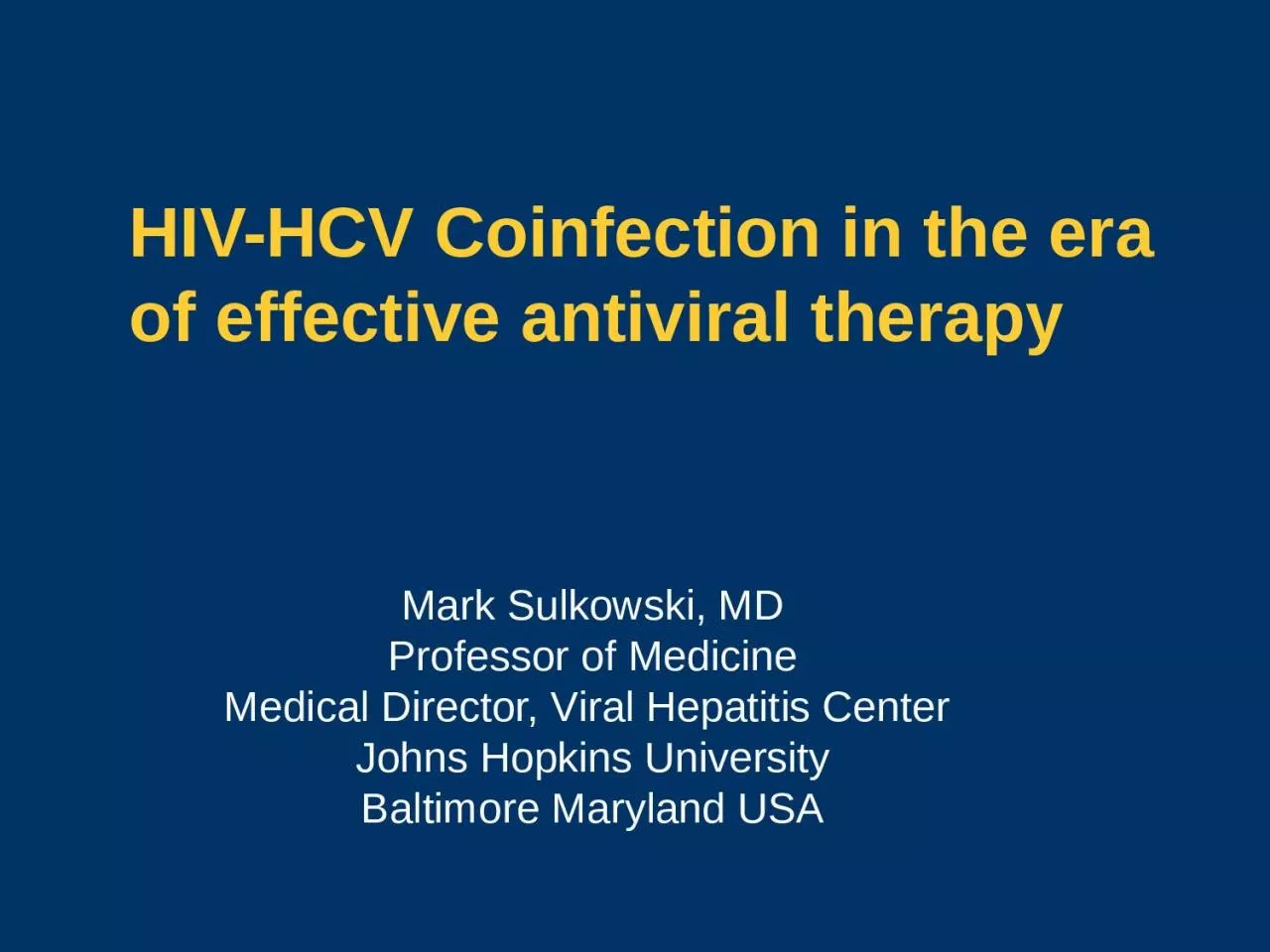

Mark Sulkowski MD Professor of Medicine Medical Director Viral Hepatitis Center Johns Hopkins University Baltimore Maryland USA Liver disease is the second leading specific causes of death amongst HIVpositive individuals in the DAD study ID: 914638
Download Presentation The PPT/PDF document "HIV-HCV Coinfection in the era of effect..." is the property of its rightful owner. Permission is granted to download and print the materials on this web site for personal, non-commercial use only, and to display it on your personal computer provided you do not modify the materials and that you retain all copyright notices contained in the materials. By downloading content from our website, you accept the terms of this agreement.
Slide1
HIV-HCV Coinfection in the era of effective antiviral therapy
Mark Sulkowski,
MD
Professor of Medicine
Medical Director, Viral Hepatitis Center
Johns Hopkins University
Baltimore Maryland USA
Slide2Liver disease is the second leading specific causes of death amongst HIV-positive individuals in the D:A:D study
AIDS. 2010 Jun 19;24(10):1537-48.
Slide3SVR or virologic relapse following HCV treatment was associated improved survival
Sulkowski MS, et al. CROI 2010. Abstract 166.
Slide4SVR rates among HIV/HCV coinfected patients treated with PegIFN alfa-2a/RBV
SVR
(%)
135
86
33
275
176
62
40
77
0
10
20
30
40
50
19
22
26
24
9
20
5
13
All patients
Black
Hispanic
Caucasian
Ribavirin
800 mg/day (n=135)
Ribavirin 1000/1200 mg/day (n=275)
Rodriguez-Torres et al.
AASLD
2009
Slide5Telaprevir and Boceprevir in HCV/HIV coinfected patients
All contraindications to PegIFN/RBV apply
Coadministration with other drugs
Highly dependent on CYP3A for clearance
Strongly induce CYP3A
Safety and efficacy not established in persons coinfected with HIV
Telaprevir and Boceprevir; Prescribing information, May 2011
Slide6Phase 2 studies of HCV PI + PR
Telaprevir
Boceprevir
Number
of patients
TVR,
38; Control, 22
BOC,
64; Control, 34
HCV population
Naïve, genotype
1
Naïve, genotype
1
HIV population
CD4 ≥500; HIV ≤100,000 c/mL
CD4 ≥
3
00; HIV ≤50 c/mL
CD4
≥ 200
cells/mm
3
HIV RNA
<
50
c/mL
Antiretroviral therapy
None (n=7)
EFV (n=16)
or ATV/r (n=15) + TDF/FTC
No NNRTIs
ATV/r
, (n=20);
DVR/r (n=16); DRV/r (n=12);
RAL(n=11)
HCV regimen
TLV 750 mg Q8H or 1125 mg Q8H (if EFV co-admin) + pegIFN-2a + RBV 800 mg/day
BOC 800 mg Q8H + pegIFN-2b
+ weight based RBV (600–1400 mg/day)
Lead-in
No
Yes
Duration of PI
12 weeks44 weeks
Duration of PR
48 weeks
48 weeks
Virologic futility rules
Week-4 or 8
or 12 HCV RNA >1000 IU/mL
Week-24 Detectable HCV RNA
Week-12 <2 log10
decline
Week-24 Detectable HCV RNA
HCV PI PK measured
Yes
Yes
ART PK measured
Yes
No
Slide7Efficacy
Slide8Undetectable HCV RNA over 24 weeks:
Telaprevir
(
12 wks) + PR Vs. PR
Slide9% Patients With Undetectable
HCV RNA
3/34
3/64
5/34
24/64
8/32
35/62
11/32
43/61
Slide10Safety and Tolerability
Slide11Telaprevir + PR
No severe rash report with TVR
TVR/PR - bilirubin AEs 27% (4/15) versus none of control (0/8)
Slide12Telaprevir + PR
Slide13Virologic Breakthrough
No HIV RNA breakthrough
HCV RNA breakthrough, 7 patients
Efavirenz, 4 of 16 Atazanavir/r, 3 of 15
Slide14Boceprevir + PR: Most Common Adverse Events With a Difference of ≥10% Between Groups
PEG2b/RBV
(N=34)
PEG2b/RBV + BOC
(N=64)
Days on study, median
166
211
Neutropenia
, (%)
3%
13%
Dysgeusia
, (%)
15%
25%
Vomiting, (%)
15%
25%
Pyrexia, (%)
21%
34%
Headache, (%)
12%
28%
Decreased Appetite, (%)
18%
30%
*A difference of ≥10% for patients receiving PEG2b/RBV+BOC when compared with PEG2b/RBV.
Slide15Safety Boceprevir + PR
PEG2b/RBV
(N = 34)
PEG2b/RBV + BOC
(N = 64)
Days on study, median
166
211
Any AE, n (%)
34 (100)
63 (98)
Serious AEs, n (%)
7 (21%)
5 (8%)
Treatment-related Treatment-emergent
AEs, n (%)
34 (100%)
61 (95%)
Study Discontinuation Due to an AE, n (%)
3 (9%)
9 (14%)
Any Drug Modification Due to an AE, n (%)
7 (21%)
12 (19%)
Slide16Boceprevir + PR: Hematologic AEs
PEG2b/RBV
(N=34)
PEG2b/RBV + BOC (n=64)
Anemia
AEs, n (%)
9 (26)
19 (30)
SAEs, n (%)
2 (6)
1 (2)
AEs leading to discontinuation, n (%)
1 (3)
1 (2)
Grade 2 (8.0 to <9.5 g/dL), n (%)
7 (21)
10 (16)
Grade 3 (6.5 to <8.0 g/dL), n (%)
1 (3)
3 (5)
Erythropoietin use, n (%)
7 (21)
17 (27)
Transfusions, n (%)
2 (6)
4 (6)
Neutropenia
AEs, n (%)
1 (3)
8 (13)
Grade 3 (<0.75x10
9
/L), n (%)
3 (9)
10 (16)
Grade 4 (<0.5x10
9
/L), n (%)
*
*
*To maintain blinding in this continuing study the table only shows data where events occurred in at least 1 patient in each treatment group.
Slide17Virologic Breakthrough
HIV RNA breakthrough, 4 patients
2 on placebo
2 on BOC + ATV/r with increase HIV RNA No HCV RNA breakthrough reported
Slide18Drug Interactions
Slide19Telaprevir – ARV Interactions
Thomas DL et al.
Clin
Infec
Diseases 2011 in press
Slide20Boceprevir Drug Interactions with ART (limited data)
Boceprevir
Effect on Concentration of PI or Concomitant Drug
Efavirenz
↓ boceprevir
Plasma trough concentrations of BOC decreased when coadministered, which may result in loss of therapeutic effect
Avoid combination
Ritonavir
↓ boceprevir
↑ or ↓ HIV protease inhibitors
Boceprevir concentrations decreased with ritonavir; effect of ritonavir-boosted HIV PIs on BOC exposure is unknown
The effect of BOC on HIV PI concentrations is unknown
Boceprevir capsules [package insert]. Whitehouse Station, NJ: Merck & Co., Inc.; 2011.
Interaction studies of BOC and
Atazanavir
/r,
Daruanvir
/r, and
Lopinavir
/r
have
been
completed.
Slide21Provisional use of HCV PIs in HIV/HCV coinfected
patients
Referral to clinical trials is strongly recommended
PegIFN + Ribavirin remains an appropriate regimen for many co-infected patient
However,
if available
, d
ata support the cautious use of telaprevir or boceprevir + PR in carefully selected patients:
No antiretroviral therapy
TVR or BOC
RAL TVR or BOC
ATV/r TVR
EFV TVR (requires increase TVR dose)
Other ARVs Insufficient data; NOT recommendedMajor limitations to therapy Efficacy and tolerability of PegIFN
Cost